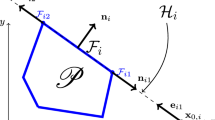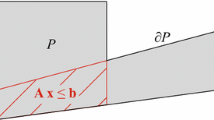Abstract
The implementation of discontinuous functions occurs in many of today’s state-of-the-art partial differential equation solvers. However, in finite element methods, this poses an inherent difficulty: efficient quadrature rules available when integrating functions whose discontinuity falls in the element’s interior are for low order degree polynomials, not easily extended to higher order degree polynomials, and cover a restricted set of geometries. Many approaches to this issue have been developed in recent years. Among them, one of the most elegant and versatile is the equivalent polynomial technique. This method replaces the discontinuous function with a polynomial, allowing integration to occur over the entire domain rather than integrating over complex subdomains. Although eliminating the issues involved with discontinuous function integration, the equivalent polynomial tactic introduces its problems. The exact subdomain integration requires a machinery that quickly grows in complexity when increasing the polynomial degree and the geometry dimension, restricting its applicability to lower order degree finite element families. The current work eliminates this issue. We provide algebraic expressions to exactly evaluate the subdomain integral of any degree polynomial on parent finite element shapes cut by a planar interface. These formulas also apply to the exact evaluation of the embedded interface integral. We provide recursive algorithms that avoid overflow in computer arithmetic for standard finite element geometries: triangle, square, cube, tetrahedron, and prism, along with a hypercube of arbitrary dimensions.










Similar content being viewed by others
Data availability
Data sharing is not applicable to this article as no datasets were generated during the current study.
References
Aragón, A. M., Duarte, C.A., Geubelle, P.H.: Generalized finite element enrichment functions for discontinuous gradient fields. Int. J. Numer. Meth. Eng. 82(2), 242–268 (2010)
Moës, N., Dolbow, J., Belytschko, T.: A finite element method for crack growth without remeshing. Int. J. Numer. Meth. Eng. 46(1), 131–150 (1999)
Aulisa, E., Capodaglio, G., Chierici, A., D’Elia, M.: Efficient quadrature rules for finite element discretizations of nonlocal equations. Numerical Methods for Partial Differential Equations. https://doi.org/10.1002/num.22833 (2021)
D’Elia, M., Du, Q., Glusa, C., Tian, X., Zhou, Z.: Numerical methods for nonlocal and fractional models. ACTA Numerica 29 (2020)
Friswell, M.I., Adhikari, S., Lei, Y.: Non-local finite element analysis of damped beams. Int. J. Solids Struct. 44(22-23), 7564–7576 (2007)
Aulisa, E., Manservisi, S., Scardovelli, R., Zaleski, S.: Interface reconstruction with least-squares fit and split advection in three-dimensional cartesian geometry. J. Comput. Phys. 225(2), 2301–2319 (2007). https://doi.org/10.1016/j.jcp.2007.03.015
Aulisa, E., Manservisi, S., Scardovelli, R.: A mixed markers and volume-of-fluid method for the reconstruction and advection of interfaces in two-phase and free-boundary flows. J. Comput. Phys. 188(2), 611–639 (2003)
Hirt, C.W., Nichols, B.D.: Volume of fluid (VOF) method for the dynamics of free boundaries. J. Comput. Phys. 39(1), 201–225 (1981)
Joulaian, M., Hubrich, S., Düster, A.: Numerical integration of discontinuities on arbitrary domains based on moment fitting. Comput. Mech. 57(6), 979–999 (2016)
Ventura, G.: On the elimination of quadrature subcells for discontinuous functions in the extended finite-element method. Int. J. Numer. Meth. Eng. 66 (5), 761–795 (2006)
Mousavi, S.E., Sukumar, N.: Numerical integration of polynomials and discontinuous functions on irregular convex polygons and polyhedrons. Comput. Mech. 47(5), 535–554 (2011)
Holdych, D.J., Noble, D.R., Secor, R.B.: Quadrature rules for triangular and tetrahedral elements with generalized functions. Int. J. Numer. Meth. Eng. 73(9), 1310–1327 (2008)
Abedian, A., Düster, A.: Equivalent legendre polynomials: numerical integration of discontinuous functions in the finite element methods. Comput. Methods Appl. Mech. Eng. 343, 690–720 (2019)
Abedian, A., Parvizian, J., Düster, A., Khademyzadeh, H., Rank, E.: Performance of different integration schemes in facing discontinuities in the finite cell method. Int. J. Comput. Methods 10(03), 1350002 (2013)
Ventura, G., Benvenuti, E.: Equivalent polynomials for quadrature in Heaviside function enriched elements. Int. J. Numer. Meth. Eng. 102(3-4), 688–710 (2015)
Gasca, M., Sauer, T.: Polynomial interpolation in several variables. Adv. Comput. Math. 12(4), 377–410 (2000)
Ma, J., Rokhlin, V., Wandzura, S.: Generalized gaussian quadrature rules for systems of arbitrary functions. SIAM J. Numer. Anal. 33(3), 971–996 (1996)
Neidinger, R.D.: Multivariate polynomial interpolation in newton forms. SIAM Rev. 61(2), 361–381 (2019)
Kees, C.E., Collins, J.H., Zhang, A.: Simple, accurate, and efficient embedded finite element methods for fluid–solid interaction. Comput. Methods Appl. Mech. Eng. 389, 114404 (2022)
Loftin, J.: Exact cutfem polynomial integration PhD thesis (2022)
Aulisa, E, Bná, S, Bornia, G: FEMuS. https://github.com/eaulisa/MyFEMuS (2014)
Balay, S., Brown, J., Buschelman, K., Eijkhout, V., Gropp, W., Kaushik, D., Knepley, M., McInnes, L.C., Smith, B., Zhang, H.: PETSC users manual revision 3.3. Computer Science Division, Argonne National Laboratory, Argonne IL (2012)
Dingle, R.: The Fermi-Dirac integrals. Applied Scientific Research Section B 6(1), 225–239 (1957)
Truesdell, C.: On a function which occurs in the theory of the structure of polymers. Ann. Math. 144–157 (1945)
Rhodes, P.: Fermi-dirac functions of integral order. Proceedings of the Royal Society of London. Series A Mathematical and Physical Sciences 204(1078), 396–405 (1950)
Lax, P.D.: Functional Analysis. Pure and Applied Mathematics: A Wiley Series of Texts, Monographs and Tracts, New York (2014)
Onural, L.: Impulse functions over curves and surfaces and their applications to diffraction. J. Math. Anal. Appl. 322(1), 18–27 (2006)
Wang, X.: Lecture Notes in Real Analysis. Springer, Cham (2018)
Saad, Y.: On the condition number of some Gram matrices arising from least squares approximation in the complex plane. Numer. Math. 48(3), 337–347 (1986)
Xu, Y.: On multivariate orthogonal polynomials. SIAM J. Math. Anal. 24(3), 783–794 (1993)
Funding
The authors gratefully acknowledge the financial support of the National Science Foundation (NSF) Division of Mathematical Sciences (DMS) program, project 1912902.
Author information
Authors and Affiliations
Corresponding author
Ethics declarations
Conflict of interest
The authors declare no competing interests.
Additional information
Publisher’s note
Springer Nature remains neutral with regard to jurisdictional claims in published maps and institutional affiliations.
Jonathon Loftin contributed equally to this work.
Appendix
Appendix
Proposition 6
Let D be a bounded connected domain with smooth boundary ∂D. Let G(x) be a smooth level set function. Let \({\Gamma } = \left \{ \boldsymbol {x}\in D : G(\boldsymbol {x}) = 0 \right \}\) be a continuous smooth embedded interface, that separates D in the two subregions D1 and D2, such that G(x) > 0 for all x ∈ D1 and G(x) < 0 for all x ∈ D2. Assume the measure μ(Γ ∩ ∂D) = 0. Then, for any differentiable function f(x)
The ∥∇G∥ term in both sides is needed since the level set G(x) only approximates the required condition, ∥∇d∥ = 1, for a true distance d(x), see Appendix in [12].
Proof
Let n on ∂D be the outer unit normal vector to D. Let \(\widehat {\boldsymbol {n}} =-\frac {\nabla G}{\| \nabla G \|}\) be defined everywhere on D. \(\widehat {\boldsymbol {n}}\) is the unit vector orthogonal to the the level curves G(x) = const, pointing in the direction of maximum decrease. On the interface Γ, \(\widehat {\boldsymbol {n}}\) is the unit outer normal to D1. Let ∂D1 = ∂D ∩ D1. Then, the boundary of D1 is piece-wise-defined by ∂D1 ∪Γ, with outer unit normal vectors n and \(\widehat {\boldsymbol {n}}\), respectively.
Observe that by using the chain rule and the derivative property of the polylogarithm, we have
Then,
Where we used (A.1) for first line equality, divergence Theorem for the second line equality, (2) for the third equality, (3) for the fourth equality, divergence Theorem for the fifth line equality, and the definition of the Dirac delta distribution for a level set in the last line equality. Note that the proof holds only if the measure μ(Γ ∩ ∂D) = 0, for an appropriate product measure μ, since from the third line to the fourth line, the integral equality on the boundary
is true only if the Heaviside function U is almost everywhere 1 on ∂D1 and almost everywhere 0 on its complement. For μ(Γ ∩ ∂D)≠ 0, we would have measurable parts of the boundary ∂D with U = 0.5, and the equality would not hold. □
Rights and permissions
Springer Nature or its licensor (e.g. a society or other partner) holds exclusive rights to this article under a publishing agreement with the author(s) or other rightsholder(s); author self-archiving of the accepted manuscript version of this article is solely governed by the terms of such publishing agreement and applicable law.
About this article
Cite this article
Aulisa, E., Loftin, J. Exact subdomain and embedded interface polynomial integration in finite elements with planar cuts. Numer Algor 94, 315–350 (2023). https://doi.org/10.1007/s11075-023-01502-3
Received:
Accepted:
Published:
Issue Date:
DOI: https://doi.org/10.1007/s11075-023-01502-3




